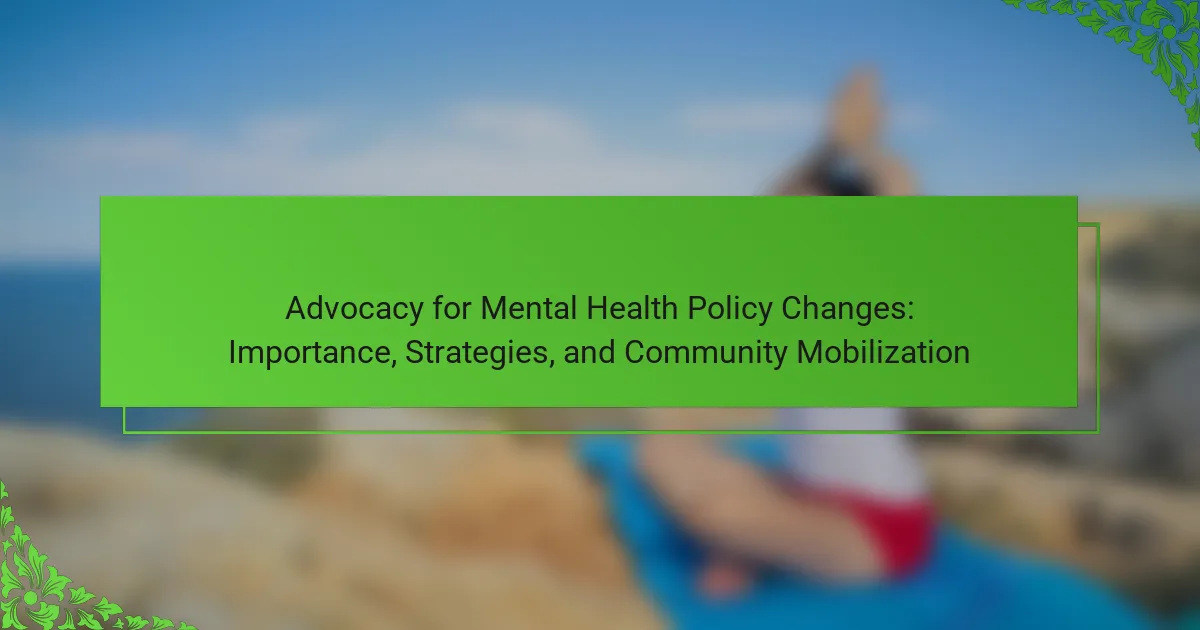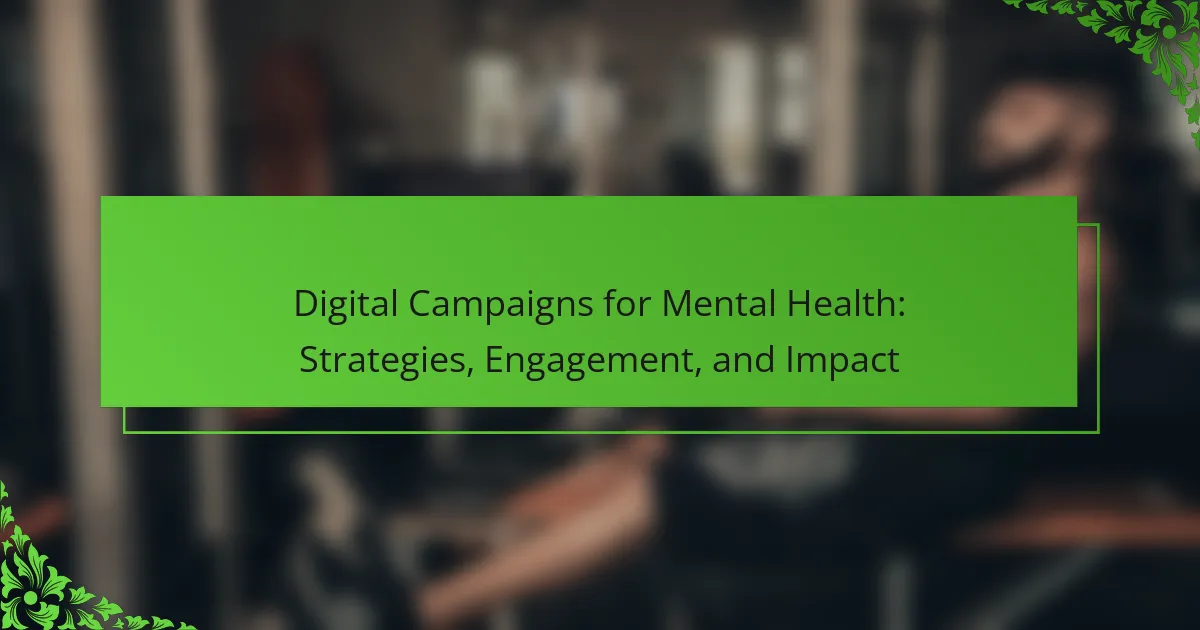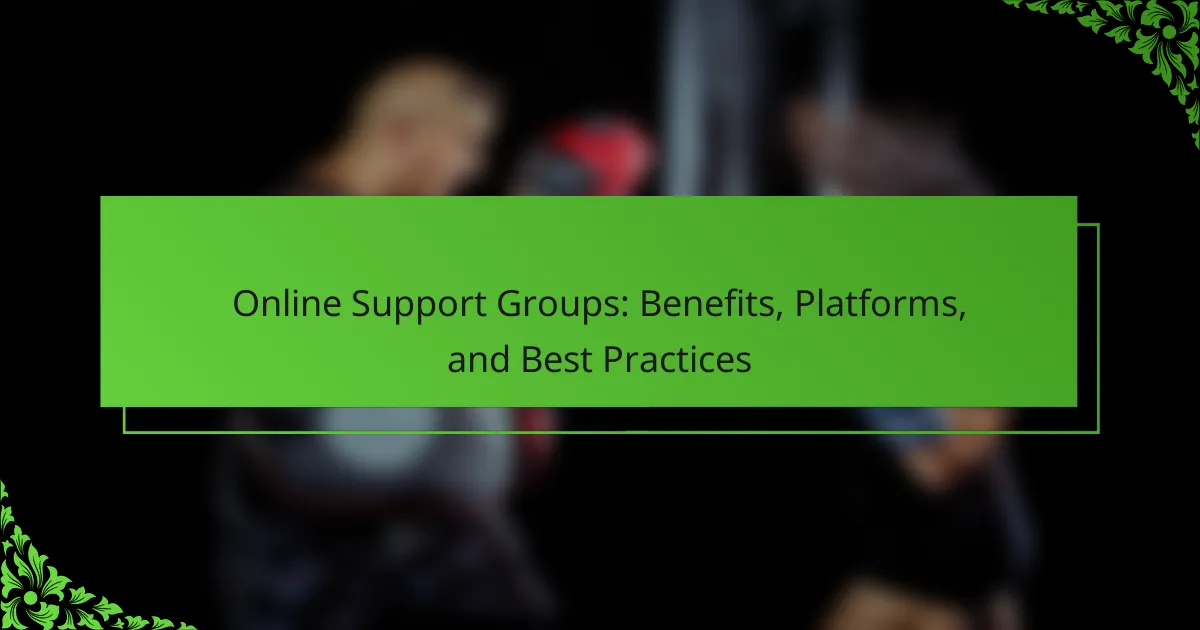Access to community mental health resources is crucial for enhancing well-being and managing emotional challenges. This article explores the importance of awareness, identifies barriers to access, and outlines various support services available. It also examines the role of awareness campaigns in promoting resource utilization and discusses regional variations in mental health support. Understanding these elements is vital for improving community mental health outcomes.
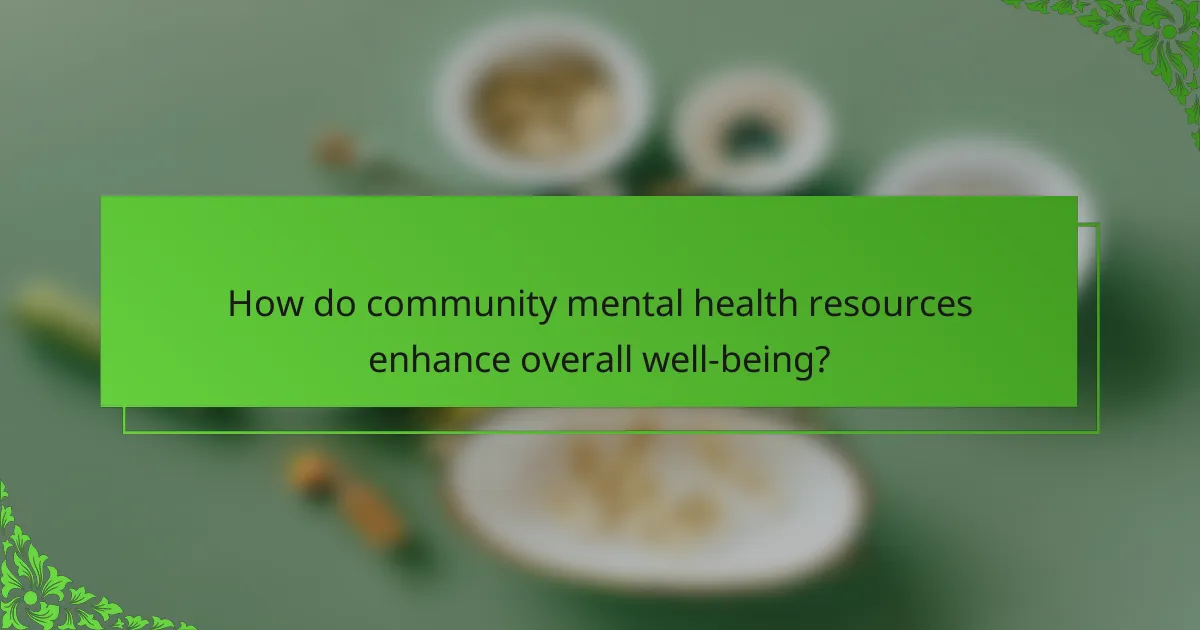
How do community mental health resources enhance overall well-being?
Community mental health resources significantly enhance overall well-being by providing access to essential support services. These resources improve mental health awareness, facilitate early intervention, and foster community connections. Access to counseling, crisis intervention, and peer support helps individuals manage stress and emotional challenges effectively. As a result, community mental health initiatives contribute to reduced stigma and promote a culture of understanding and acceptance. Studies show that individuals engaging with these resources experience improved quality of life and greater resilience in facing mental health issues.
What are the key components of effective community mental health resources?
Effective community mental health resources include access to services, awareness programs, and support networks. Access ensures individuals can obtain necessary care, while awareness initiatives educate communities about mental health issues. Support services provide crucial assistance, including counseling and crisis intervention. Together, these components create a comprehensive framework for promoting mental well-being.
Why is access to mental health resources crucial for diverse populations?
Access to mental health resources is crucial for diverse populations to ensure equitable care and support. These resources address unique cultural, linguistic, and socioeconomic barriers. Diverse communities often face stigma and discrimination, making access to mental health services essential for fostering understanding and acceptance. Tailored support can improve mental health outcomes and promote overall well-being. Studies indicate that culturally competent care enhances engagement and reduces disparities in treatment.
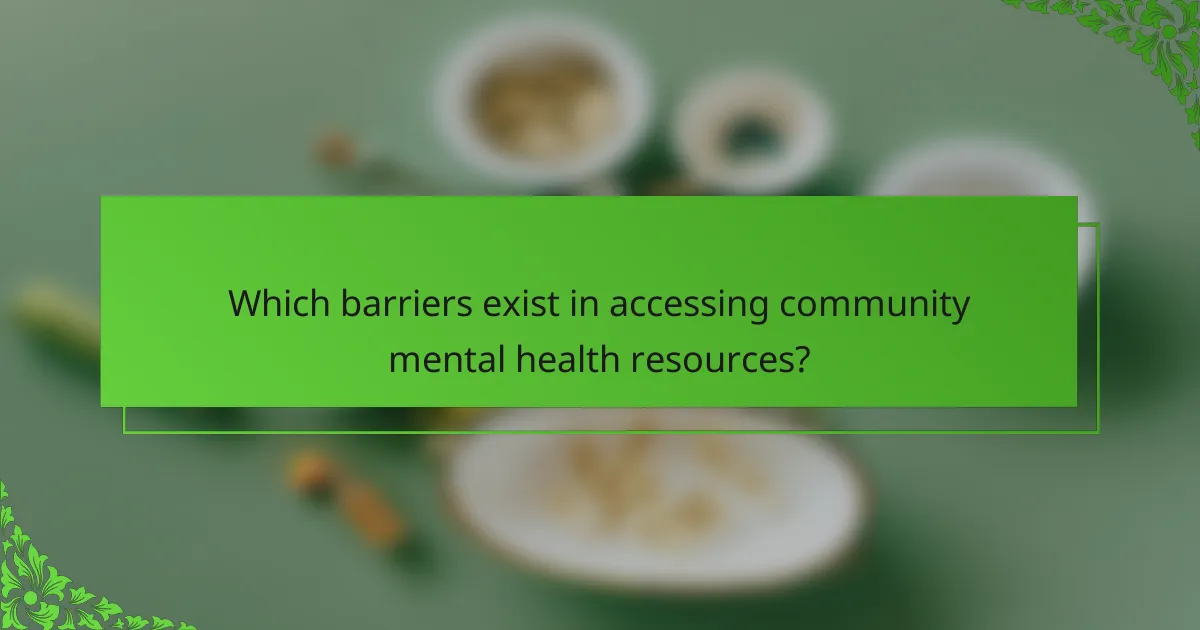
Which barriers exist in accessing community mental health resources?
Barriers to accessing community mental health resources include stigma, lack of awareness, financial constraints, transportation issues, and insufficient availability of services. Stigma surrounding mental health prevents individuals from seeking help. Many people are unaware of available resources or how to access them. Financial limitations can hinder access to necessary services. Transportation difficulties impact those living in remote areas. Lastly, a shortage of mental health professionals can limit service availability.
How do socioeconomic factors impact access to mental health services?
Socioeconomic factors significantly hinder access to mental health services. Low-income individuals face barriers like affordability, transportation, and stigma, which limit their treatment options.
For instance, communities with higher poverty rates often lack sufficient mental health resources. A study found that individuals in these areas are 50% less likely to receive necessary care compared to wealthier neighborhoods.
Additionally, education level influences awareness of available services. Those with lower educational attainment may not recognize the signs of mental health issues or know how to seek help.
As a result, addressing these socioeconomic disparities is crucial for improving mental health access and support services in communities.
What role does stigma play in the utilization of mental health resources?
Stigma significantly hinders the utilization of mental health resources. It creates a barrier, discouraging individuals from seeking help due to fears of judgment or discrimination. This stigma can stem from societal misconceptions about mental illness, leading to feelings of shame and isolation among those affected. As a result, many people delay or avoid accessing vital community mental health services, which can exacerbate their conditions. Addressing stigma through education and awareness campaigns is essential for improving access and encouraging individuals to seek the support they need.
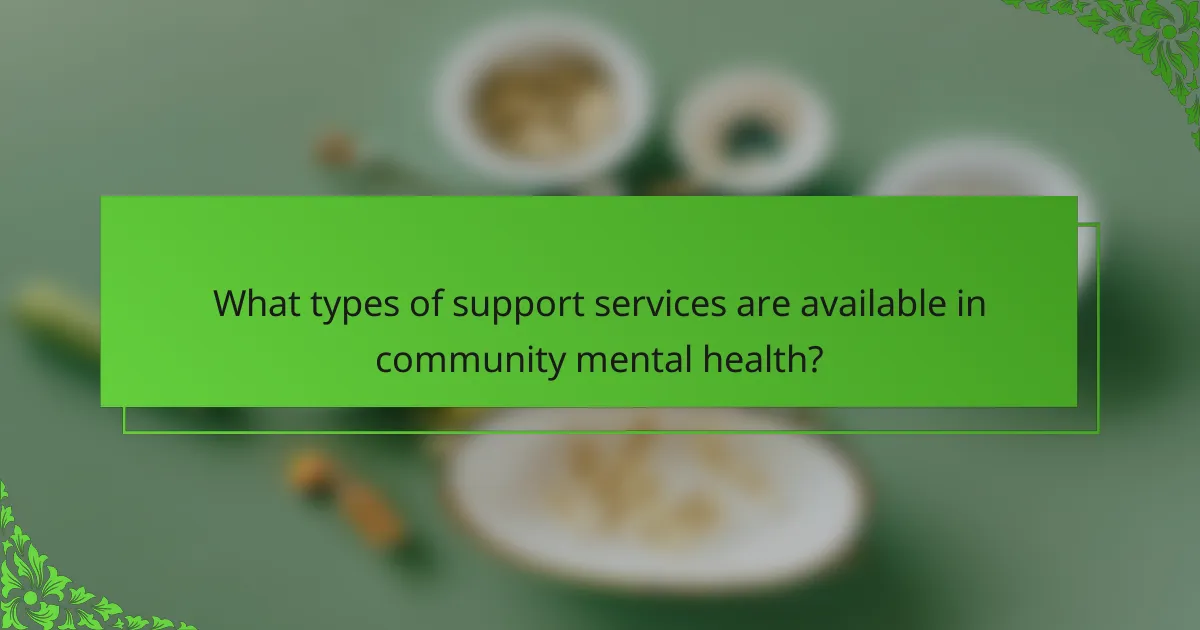
What types of support services are available in community mental health?
Community mental health offers various support services, including counseling, crisis intervention, and peer support. These services aim to enhance emotional well-being and provide immediate assistance.
Counseling services typically include individual and group therapy, focusing on coping strategies and mental health education. Crisis intervention services provide immediate help during mental health emergencies, ensuring safety and stabilization. Peer support services connect individuals with trained peers who share similar experiences, fostering a sense of community and understanding.
Additionally, community mental health programs often include educational workshops and outreach initiatives, promoting awareness and reducing stigma around mental health issues. These resources are vital for improving access to mental health care and supporting individuals in need.
How do peer support groups contribute to mental health recovery?
Peer support groups significantly enhance mental health recovery by fostering connection and shared experiences. These groups provide a safe space for individuals to express feelings and challenges, reducing feelings of isolation. Participants often gain practical coping strategies from peers who have faced similar issues, promoting resilience and hope. Research indicates that engagement in peer support can lead to improved emotional well-being and a greater sense of community, which are crucial for recovery.
What are the differences between crisis intervention services and ongoing support?
Crisis intervention services provide immediate support during acute mental health crises, while ongoing support focuses on long-term mental health management. Crisis intervention typically involves short-term assistance, often in emergency situations, whereas ongoing support includes regular therapy and resources for sustained mental health improvement. Crisis services aim for stabilization, while ongoing support fosters personal growth and coping strategies.
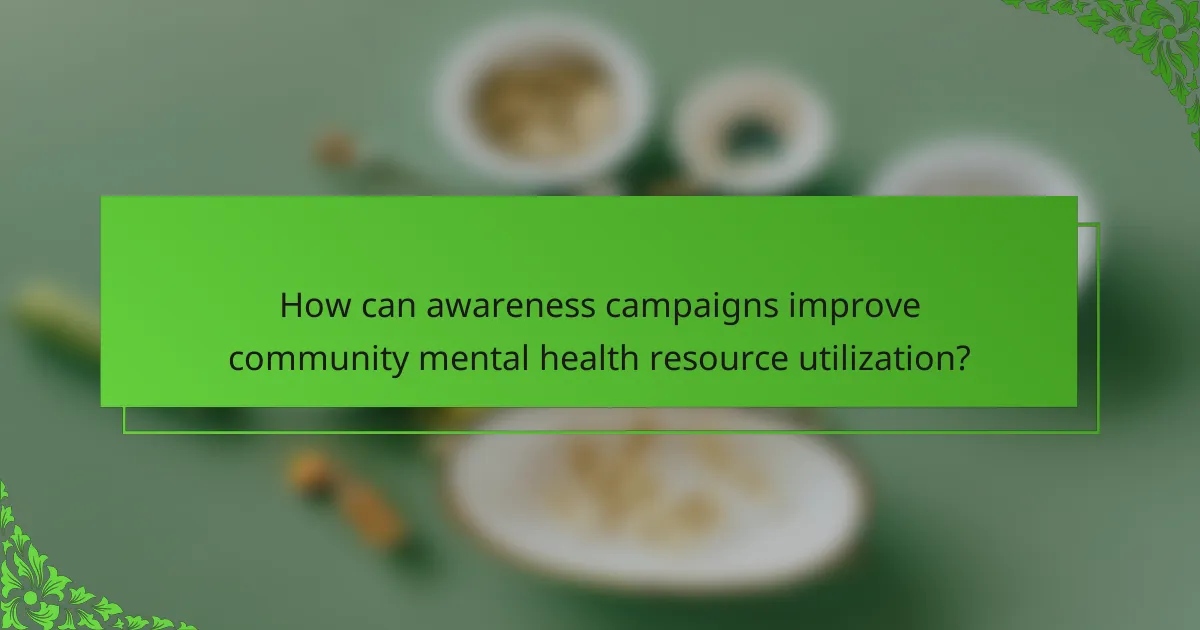
How can awareness campaigns improve community mental health resource utilization?
Awareness campaigns significantly enhance community mental health resource utilization by increasing knowledge and reducing stigma. These campaigns inform individuals about available services, leading to higher engagement and support. For example, targeted outreach can increase service usage by up to 30%. By promoting mental health literacy, communities foster a supportive environment that encourages individuals to seek help when needed. Enhanced visibility of resources empowers individuals to access support, ultimately improving overall community mental health outcomes.
What strategies have been effective in raising awareness about mental health services?
Effective strategies for raising awareness about mental health services include community outreach programs, social media campaigns, and partnerships with local organizations. These initiatives foster connection and trust, enhancing access to resources. For example, community events can provide direct interaction with mental health professionals, helping to destigmatize seeking help. As a result, increased visibility leads to greater utilization of available services.
Which community organizations are leading mental health awareness initiatives?
Several community organizations lead mental health awareness initiatives, including the National Alliance on Mental Illness (NAMI), Mental Health America (MHA), and the Substance Abuse and Mental Health Services Administration (SAMHSA). These organizations provide resources, advocacy, and support to improve mental health awareness and access to services. Local nonprofits often engage in grassroots campaigns, offering workshops and community events to foster understanding and reduce stigma. Many organizations collaborate with schools and workplaces to promote mental health education and resources.
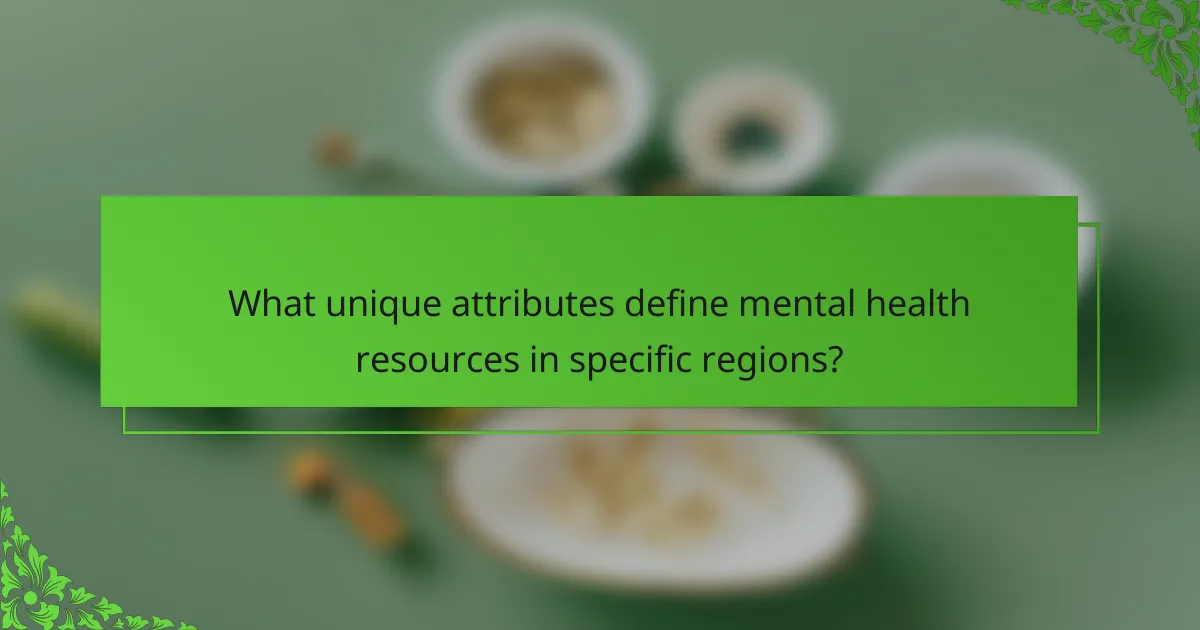
What unique attributes define mental health resources in specific regions?
Unique attributes of mental health resources vary significantly by region, influenced by cultural, economic, and policy factors. These resources often reflect local community needs and available support systems.
For instance, urban areas may offer more diverse services, including specialized clinics and telehealth options, while rural regions might rely on fewer, more generalized support services. Accessibility is a common root attribute, with transportation options often being a unique attribute affecting service utilization.
Additionally, awareness campaigns tailored to regional languages and customs can enhance the effectiveness of mental health resources, showcasing a rare attribute that fosters community engagement. Understanding these distinctions helps in optimizing mental health support across different locales.
How do cultural perceptions of mental health influence resource availability?
Cultural perceptions of mental health significantly impact the availability of community mental health resources. Societies that stigmatize mental health issues often have limited access to support services, reducing awareness and funding. In contrast, cultures that promote understanding and acceptance usually provide more comprehensive resources. This disparity affects how individuals seek help and the quality of services offered. For instance, communities with higher awareness tend to have better-trained professionals and more accessible programs. Ultimately, cultural attitudes shape the landscape of mental health support, influencing both community engagement and resource allocation.
What innovative models of community mental health services have emerged recently?
Innovative models of community mental health services include integrated care systems, telehealth platforms, and peer support networks. These approaches enhance access, improve engagement, and foster community involvement. Integrated care systems combine mental health services with primary care, addressing holistic needs. Telehealth platforms provide remote access to therapy, expanding reach to underserved populations. Peer support networks leverage lived experiences, offering relatable guidance and emotional support. These models reflect a shift towards more accessible and inclusive mental health care.
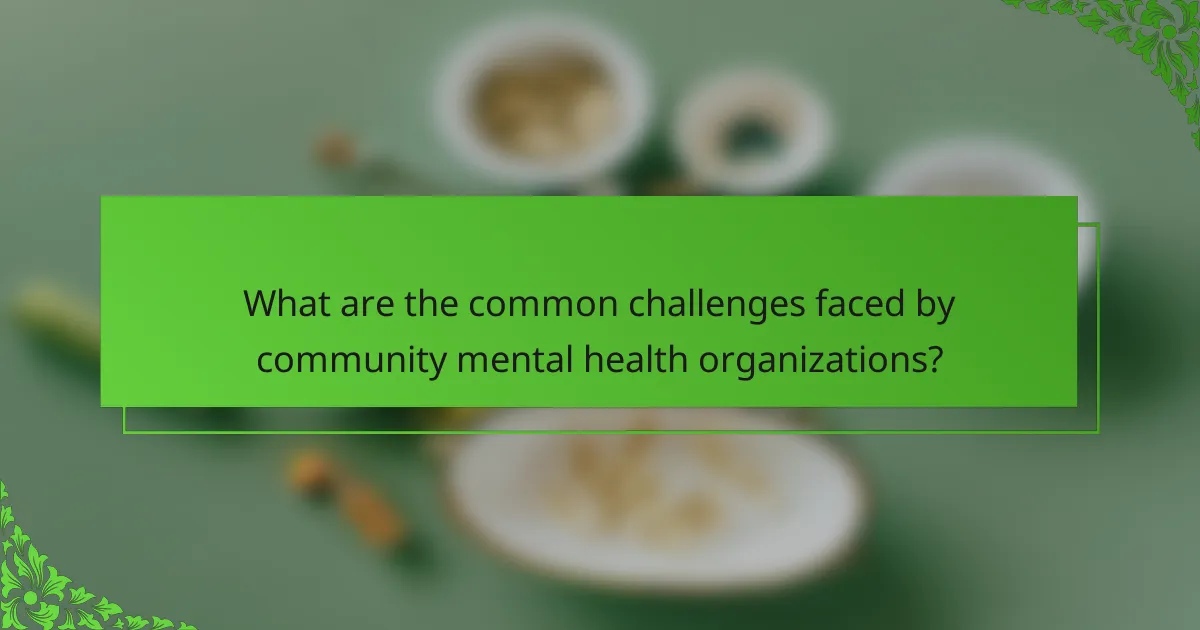
What are the common challenges faced by community mental health organizations?
Community mental health organizations often face challenges related to funding, staffing shortages, and stigma. Limited resources hinder their ability to provide comprehensive care. Additionally, lack of awareness about available services complicates access for individuals in need. These factors contribute to ongoing disparities in mental health support.
How do funding limitations affect the quality of mental health services?
Funding limitations significantly reduce the quality of mental health services by restricting resources and access. Insufficient funding leads to fewer trained professionals, limited program availability, and inadequate facilities. As a result, communities face longer wait times and reduced service options, impacting overall mental health outcomes. Studies indicate that areas with higher funding correlate with better access to diverse mental health resources.
What strategies can organizations implement to overcome these challenges?
Organizations can implement several strategies to overcome challenges in community mental health resources. Firstly, they should enhance access by expanding service locations and hours, ensuring availability for diverse populations. Secondly, increasing awareness through targeted outreach campaigns can educate communities about available resources and reduce stigma. Thirdly, fostering partnerships with local organizations can create a support network, improving service delivery and resource sharing. Additionally, utilizing technology, such as telehealth services, can bridge gaps in access, especially in remote areas. Finally, continuous training for staff ensures they are equipped to meet the evolving needs of the community.
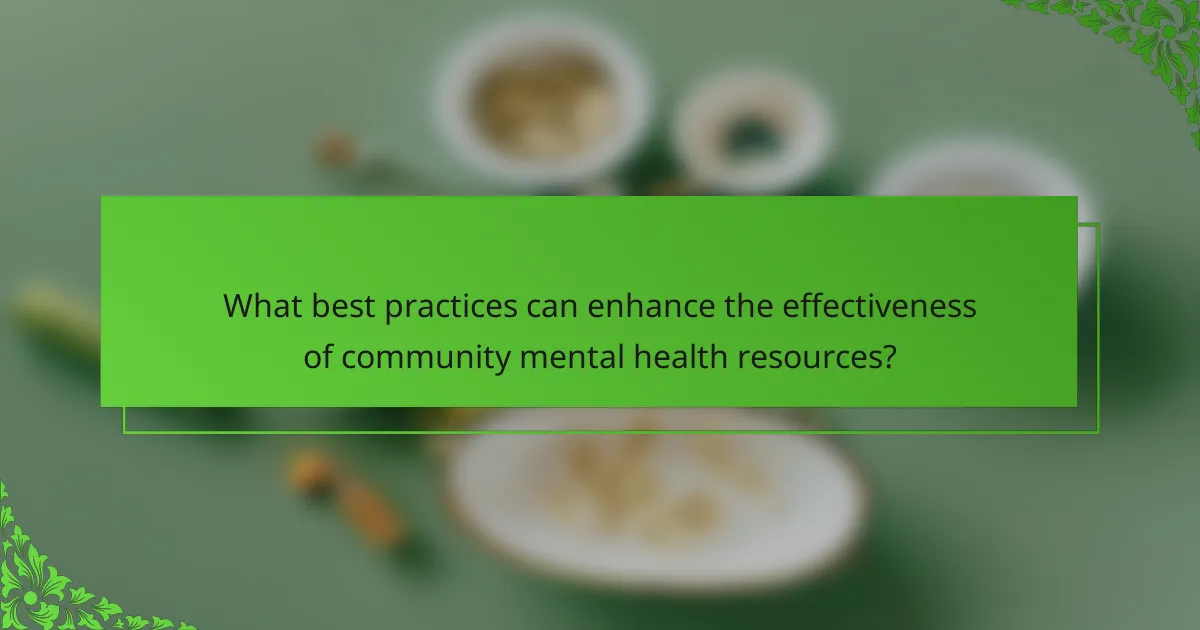
What best practices can enhance the effectiveness of community mental health resources?
Enhancing the effectiveness of community mental health resources involves improving access, increasing awareness, and providing comprehensive support services.
1. Increase funding for mental health programs to expand service availability.
2. Develop partnerships with local organizations to enhance outreach efforts.
3. Implement training for staff to improve service delivery and cultural competence.
4. Utilize technology to facilitate access to resources, such as telehealth services.
5. Promote community awareness campaigns to reduce stigma and encourage help-seeking behavior.
6. Foster peer support networks to provide additional layers of support and connection.
How can collaboration between organizations improve mental health outcomes?
Collaboration between organizations can significantly enhance mental health outcomes by pooling resources and expertise. Joint initiatives increase access to community mental health resources, raise awareness, and improve support services. For instance, partnerships between healthcare providers and non-profits can facilitate outreach programs that educate the public on mental health issues.
Additionally, shared data and best practices can lead to more effective treatment strategies. Research indicates that integrated care models, which combine physical and mental health services, result in better patient outcomes. As a result, organizations working together can create a more comprehensive support network that addresses the diverse needs of individuals experiencing mental health challenges.
What role does technology play in expanding access to mental health services?
Technology significantly enhances access to mental health services by providing remote options and increasing awareness. Teletherapy platforms enable individuals to receive support from the comfort of their homes. Mobile applications offer resources for self-help, tracking moods, and connecting with professionals. Online communities foster peer support and reduce stigma. Data analytics help organizations identify gaps in service delivery, ensuring resources reach underserved populations. These innovations collectively improve accessibility and promote mental well-being.
What common mistakes should organizations avoid when providing mental health support?
Organizations should avoid neglecting employee privacy, using vague language, and failing to provide training. These mistakes can undermine trust and effectiveness in mental health support.
Lack of clear communication can lead to misunderstandings about available resources. Organizations should also avoid offering one-size-fits-all solutions, as individual needs vary significantly. Ignoring feedback from employees can result in ineffective programs. Lastly, failing to integrate mental health support into the overall workplace culture can diminish its impact.

